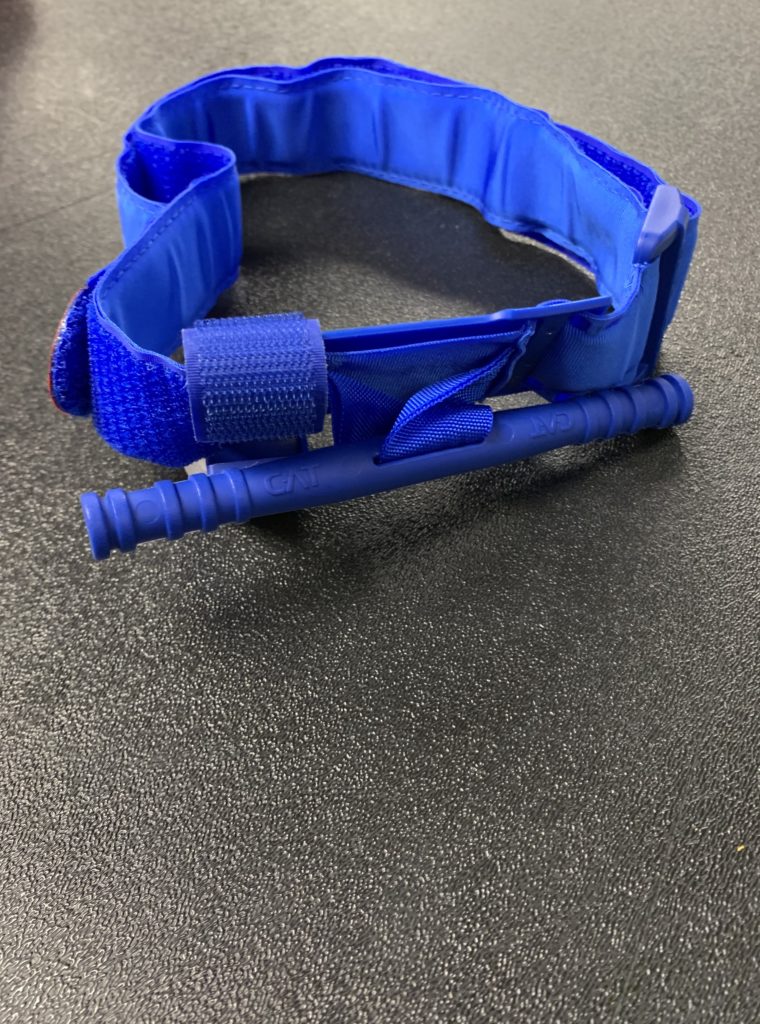
One of the many ways to stop bleeding is with a tourniquet
Students learned how to stop life-threatening bleeding
Stop the Bleed, a program at North Dakota State University which offers knowledge in managing uncontrolled bleeding, held a training on Nov. 12.
Throughout the training Stephanie Youngs, a nursing student, walked everyone through the steps of assisting someone in first aid when it comes to injuries that cause life-threatening bleeding.
The purpose of the training was to teach everyone how to recognize life-threatening bleeding, how to identify where the bleeding is coming from and how to take the steps to control and stop the bleeding.
Youngs first explained that the number one cause of preventable death is bleeding saying that situations that can cause life-threatening bleeding include active shootings, car accidents and farming accidents.
“You never know when something could happen and it’s just of benefit to have the knowledge even if it’s not used.”
Michael Teener, emergency management student
“Its actually more common to see serious bleeding in everyday injuries, so a car accident, a farming accident or something of that nature,” Youngs pointed out.
To start out, Youngs mentioned that before treating the victim, being safe yourself is important.
“You do have to know that your safety is the main priority even if other people are hurt,” Youngs explained. “If you get hurt then you can’t help other people.”
Youngs then talked about the ABC’s of bleeding control with the ‘A’ standing for alert. “Your first step is to call 911, try to stay on the line if you can just because they will walk you through the situation.”
“Even if you don’t feel comfortable being in that hands-on situation, you can still help by dialing 911,” Youngs said.
When on the phone with 911, Youngs said to inform the dispatcher when the incident occurred, your location, the number and status of victims and the threats to your own safety.
The next step discussed was to look for where the bleeding is coming from. “The most important step is to find the source of bleeding. This can be difficult if it is under clothing,” Youngs said.
What someone can look for is continuous, large-volume bleeding or pooling of blood.
Youngs detailed that arms, legs, neck and armpits are the places where bleeding can be stopped easier while bleeding in the abdomen needs to be treated in a hospital or trauma center due to internal bleeding.
On small wounds, pressure can be applied to the wound. One can use gauze or small amounts of fabric to apply pressure to stop the bleeding.
On larger wounds when pressure isn’t effective, gauze and fabric can be tightly packed into the wound which can help sop the bleeding.
For wounds on limbs, a tourniquet can be used. A tourniquet is a band that is applied two to three inches above the wound and is tightened to slow the blood flow.
When using the tourniquet Youngs said, “This is very painful, but it is lifesaving.”
Though tourniquets were once advised not to be used because they were thought to lead to limb loss, Shannon David, an associate professor of health, nutrition and exercise, said that limb loss because of a tourniquet isn’t very common.
David also mentioned that if a tourniquet isn’t available, a man’s belt can be used as well.
On campus, there are three Stop the Bleed kits which each include a tourniquet, gloves, dressings, trauma shears and instructions. One kit is located in the Memorial Union and the other two are in facility shops.
As the Stop the Bleed Program on campus has recently received a $18,000 grant from the NDSU Alumni Foundation, ten more kits will be placed around campus, but the locations are still to be determined.
Michael Teener, a emergency management student, described the purpose of the program more in depth and how the grant will help expand the program.
Teener first discussed the background of Stop the Bleed which initially started after the Sandy Hook Elementary school shooting in 2012.
Teener explained that after the shooting the American College of Surgeons started the Hartford Consensus which created protocol for national policy to enhance the survivability of mass shootings.
Since then Stop the bleed has expanded throughout the nation and even internationally. Stop the Bleed has been at NDSU for two years now.
As far as where the program on campus wants to go, Teener explained how the grant money is being used.
“Right now we’re building out the number of instructors we have so that’s going to health sciences, anyone in the nursing program and emergency management (EM) students.”
Though Stop the Bleed is offered to students in the Health Professions, Teener explained that the long term goal is to have the program be part of orientation for freshmen to take along with the domestic violence training.
Part of the programs goal is to have RA’s and faculty trained as Teener hopes to have courses offered regularly.
Though Teener mentioned that he notices not a lot of people are aware of the program, he described why students should care and become involved.
“I think it matters to be able to help people,” Teener said. “You never know when something could happen and it’s just of benefit to have the knowledge even if it’s not used.”
Information about the national Stop the Bleed program can be found at: https://www.stopthebleed.org/
Information about active shooting safety can be found at the university Police website at: https://www.ndsu.edu/police_safety/universitypolice/active_shooter_awareness/
